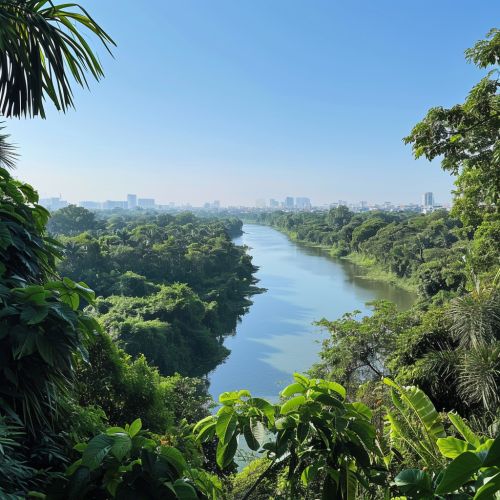Saigon River
Geography
The Saigon River is a significant waterway located in Southeast Asia, specifically in the southern region of Vietnam. The river originates from the Central Highlands, a plateau region in the southern part of the country, and flows southwards towards the South China Sea. The Saigon River is approximately 230 kilometers long, making it one of the longest rivers in Vietnam.


The river's basin covers an extensive area of about 47,000 square kilometers, which includes parts of the provinces of Lam Dong, Binh Phuoc, Tay Ninh, and Dong Nai, as well as the city of Ho Chi Minh City. The Saigon River plays a crucial role in the hydrological system of this region, contributing to the water supply for agricultural, industrial, and domestic uses.
Hydrology
The hydrology of the Saigon River is influenced by the monsoon climate of the region. The river experiences two distinct seasons: the wet season from May to November, and the dry season from December to April. During the wet season, the river's water level rises due to heavy rainfall, while in the dry season, the water level drops significantly.
The Saigon River's flow regime is characterized by its high variability, with the maximum discharge occurring during the wet season. The river's average annual discharge is approximately 600 cubic meters per second. However, during peak flow periods, the discharge can exceed 2,000 cubic meters per second.
Ecology
The Saigon River is home to a diverse range of aquatic species. The river's ecosystem includes numerous species of fish, such as the Mekong giant catfish, one of the world's largest freshwater fish, and the Siamese fighting fish, known for its vibrant colors and aggressive behavior. The river also supports a variety of bird species, including the little egret, a small white heron, and the black-crowned night heron, a bird known for its nocturnal habits.
The river's banks are lined with a variety of vegetation, including mangrove forests in the lower reaches of the river. These mangroves play a crucial role in the river's ecosystem, providing a habitat for numerous species and acting as a natural barrier against coastal erosion.
Economic Significance
The Saigon River has significant economic importance for the region. It serves as a vital waterway for the transportation of goods and people, particularly in Ho Chi Minh City, the largest city in Vietnam. The river is navigable for large vessels up to the port of Saigon, one of the busiest ports in Vietnam.
The river also plays a crucial role in the region's agriculture. The fertile alluvial soils along the river's banks are ideal for the cultivation of rice, the country's staple food. In addition, the river provides water for irrigation and is a source of fish for local communities.
Environmental Issues
Like many rivers worldwide, the Saigon River faces several environmental challenges. These include pollution from industrial and domestic waste, overfishing, and habitat destruction due to urbanization and deforestation. These issues have led to a decline in the river's water quality and have threatened its biodiversity.
Efforts are being made to address these issues, including the implementation of stricter pollution controls and the promotion of sustainable fishing practices. However, the effectiveness of these measures is yet to be seen.
